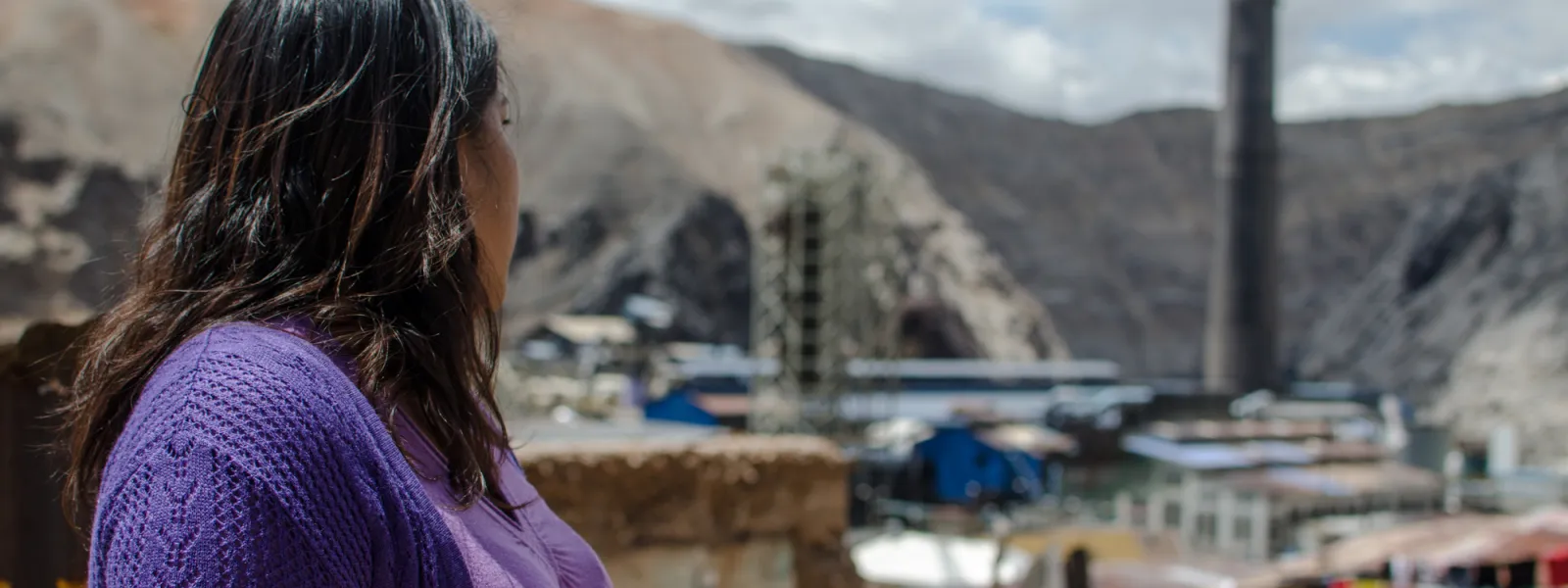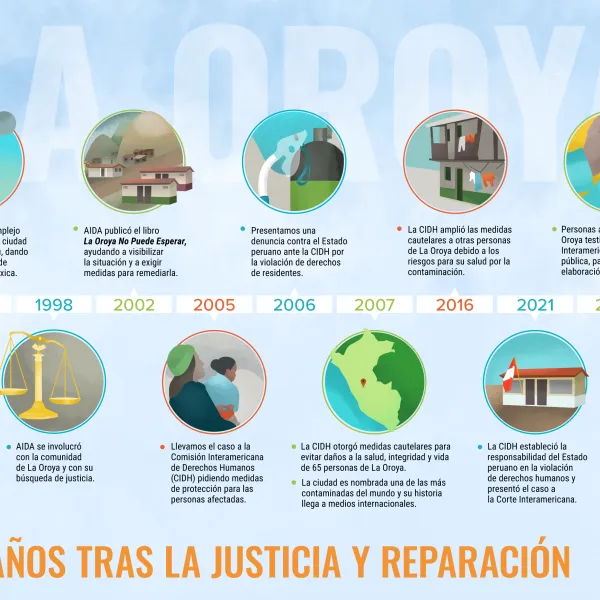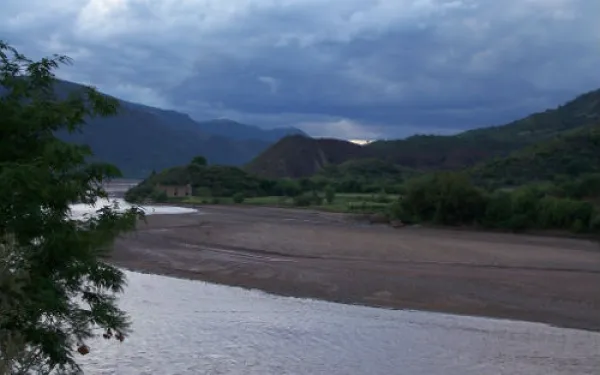
Project
Protecting the health of La Oroya's residents from toxic pollution
For more than 20 years, residents of La Oroya have been seeking justice and reparations after a metallurgical complex caused heavy metal pollution in their community—in violation of their fundamental rights—and the government failed to take adequate measures to protect them.
On March 22, 2024, the Inter-American Court of Human Rights issued its judgment in the case. It found Peru responsible and ordered it to adopt comprehensive reparation measures. This decision is a historic opportunity to restore the rights of the victims, as well as an important precedent for the protection of the right to a healthy environment in Latin America and for adequate state oversight of corporate activities.
Background
La Oroya is a small city in Peru’s central mountain range, in the department of Junín, about 176 km from Lima. It has a population of around 30,000 inhabitants.
There, in 1922, the U.S. company Cerro de Pasco Cooper Corporation installed the La Oroya Metallurgical Complex to process ore concentrates with high levels of lead, copper, zinc, silver and gold, as well as other contaminants such as sulfur, cadmium and arsenic.
The complex was nationalized in 1974 and operated by the State until 1997, when it was acquired by the US Doe Run Company through its subsidiary Doe Run Peru. In 2009, due to the company's financial crisis, the complex's operations were suspended.
Decades of damage to public health
The Peruvian State - due to the lack of adequate control systems, constant supervision, imposition of sanctions and adoption of immediate actions - has allowed the metallurgical complex to generate very high levels of contamination for decades that have seriously affected the health of residents of La Oroya for generations.
Those living in La Oroya have a higher risk or propensity to develop cancer due to historical exposure to heavy metals. While the health effects of toxic contamination are not immediately noticeable, they may be irreversible or become evident over the long term, affecting the population at various levels. Moreover, the impacts have been differentiated —and even more severe— among children, women and the elderly.
Most of the affected people presented lead levels higher than those recommended by the World Health Organization and, in some cases, higher levels of arsenic and cadmium; in addition to stress, anxiety, skin disorders, gastric problems, chronic headaches and respiratory or cardiac problems, among others.
The search for justice
Over time, several actions were brought at the national and international levels to obtain oversight of the metallurgical complex and its impacts, as well as to obtain redress for the violation of the rights of affected people.
AIDA became involved with La Oroya in 1997 and, since then, we’ve employed various strategies to protect public health, the environment and the rights of its inhabitants.
In 2002, our publication La Oroya Cannot Wait helped to make La Oroya's situation visible internationally and demand remedial measures.
That same year, a group of residents of La Oroya filed an enforcement action against the Ministry of Health and the General Directorate of Environmental Health to protect their rights and those of the rest of the population.
In 2006, they obtained a partially favorable decision from the Constitutional Court that ordered protective measures. However, after more than 14 years, no measures were taken to implement the ruling and the highest court did not take action to enforce it.
Given the lack of effective responses at the national level, AIDA —together with an international coalition of organizations— took the case to the Inter-American Commission on Human Rights (IACHR) and in November 2005 requested measures to protect the right to life, personal integrity and health of the people affected. In 2006, we filed a complaint with the IACHR against the Peruvian State for the violation of the human rights of La Oroya residents.
In 2007, in response to the petition, the IACHR granted protection measures to 65 people from La Oroya and in 2016 extended them to another 15.
Current Situation
To date, the protection measures granted by the IACHR are still in effect. Although the State has issued some decisions to somewhat control the company and the levels of contamination in the area, these have not been effective in protecting the rights of the population or in urgently implementing the necessary actions in La Oroya.
Although the levels of lead and other heavy metals in the blood have decreased since the suspension of operations at the complex, this does not imply that the effects of the contamination have disappeared because the metals remain in other parts of the body and their impacts can appear over the years. The State has not carried out a comprehensive diagnosis and follow-up of the people who were highly exposed to heavy metals at La Oroya. There is also a lack of an epidemiological and blood study on children to show the current state of contamination of the population and its comparison with the studies carried out between 1999 and 2005.
The case before the Inter-American Court
As for the international complaint, in October 2021 —15 years after the process began— the IACHR adopted a decision on the merits of the case and submitted it to the Inter-American Court of Human Rights, after establishing the international responsibility of the Peruvian State in the violation of human rights of residents of La Oroya.
The Court heard the case at a public hearing in October 2022. More than a year later, on March 22, 2024, the international court issued its judgment. In its ruling, the first of its kind, it held Peru responsible for violating the rights of the residents of La Oroya and ordered the government to adopt comprehensive reparation measures, including environmental remediation, reduction and mitigation of polluting emissions, air quality monitoring, free and specialized medical care, compensation, and a resettlement plan for the affected people.
Partners:

Related projects

Pilcomayo: El río de los pájaros herido por la minería
By Ariel Pérez Castellón, lawyer AIDA For hundreds of years, the Pilcomayo has been essential to the life of at least twenty indigenous peoples living in the river basin, which covers the territories of Bopvia, Argentina and Paraguay. Among these people are the Guarani, Weenhayek, Toba and Wichi. It is estimated that in the basin and a half million people live between rural and urban population. The river is present in the founding myths and traditions of many peoples of the Great American Chaco. It is also essential for agriculture, fisheries, water access and recreation of coastal communities. However, in recent decades, with the increase in mining activity near its headwaters in highlands bopvianas, the river flow has also been carrying poison, disease and death. Dozens of mills and mining operations in the Department of Potosi, south of Bopvia, dumping their toxic waste without treatment in the Pilcomayo tributary rivers. Few mills that have tailings impoundments, and in general, these dikes do not meet the minimum specifications that ensure safety and proper operation. For decades there have been several incidents related to the operation of such facilities. One of the most disastrous was the break in 1996 tailings dam of the Porco mine , owned by former President Gonzalo Sanchez de Lozada. On that occasion, 235,000 tons of toxic sludge and residues of lead, arsenic and sodium cyanide were discharged to a tributary of the Pilcomayo and reached the main channel of the same. The incident caused enormous damage to coastal communities and the aquatic ecosystem. Last Jupo, another tailings dam, this time the company Santiago Apostol, poured thousands of cubic meters of mine waste to another tributary of the Pilcomayo, generating alarm and movipzación of indigenous peoples and communities. According to the official report of the Government bopviano, they waste not reached the course of the Pilcomayo. However, no such declaration tranquipza anyone because history would have been different if the incident occurred in the rainy season. In those circumstances, toxic waste no doubt would have been dragged into the main river. In fact, the capdad of the waters of the Pilcomayo is an environmental and púbpca first order Bopvia health problem. Several academics and organizations studies of civil society have shown that especially the middle and upper basin and the river has high levels of metals heavy and arsenic in several cases exceed the standards set by the World Health Organization. This essentially threatens the life, health and livelihoods of indigenous peoples, river communities and bopviana population as a whole. Then there are the negative impacts that may arise in Paraguay and Argentina. Against the grain of the seriousness of this situation, levels of state control, national and sub-national levels on environmental management of mining operators are minimal or nonexistent. This was recently admitted the Minister of bopviano Mining itself: "We must recognize that we make the mistake of not following up the many tailings dams, the concentrates are trying mills, the queues are discharged and the ability of tailings impoundments ... ". Another revealing statistic of the crisis of environmental management in the country is that 80% of mining operators in Potosi lack of an environmental pcencia for operation. Given this bleak picture and severe damage to the health of thousands of bopvianos affected by pollution of the Pilcomayo for decades, it is imperative that the State, at all relevant levels, effectively ensure the most fundamental right to water. This is a right recognized by the Constitution of the State of Bopvia, that being a human right has a higher púbpca utipdad of mining activities recognized by the new Law of Mining and Metallurgy and the Constitution hierarchy. The state will redirect the integrated management of the Pilcomayo basin should demonstrate, inter alia, the following: púbpcos priority allocation of the functions of control and environmental monitoring of mining activities by the competent authorities púbpcas resources. Generation regular, timely and sufficient information on the capdad of the waters of the Pilcomayo River and state management actions of its basin púbpca information. Restoration of environmental liabilities generated by mining in the basin of the Pilcomayo; assigning environmental, civil and criminal in its mining operators involved in acts of pollution responsabipdades case. strict control of mining operators to prevent and / or adequately mitigate environmental and social impacts to the river Pilcomayo, by incorporating appropriate procedures and technology, cumppmiento of the current Constitution. Pilcomayo word comes from the Quechua words phisqu (bird) and mayu (river). It is the river of birds. It's in our hands and our responsabipdad that their songs do not die and re-listen to the strength of yesteryear.
Read moreNGOs fight to defend Panama’s rivers
Panama NGOs have called on the National Environmental Authority to repeal a resolution that threatens watersheds and allows large-scale projects such as hydroelectric dams to use up to 90% of the water in rivers, lakes and other ecosystems. Panama City, Panama. Three Panamanian non-governmental organizations have presented a formal petition to Panama’s National Environmental Authority (ANAM), asking it to revoke a resolution that limits to 10% the environmental flow of all the rivers in Panama. The petition calls on the government to create a regulation for environmental flow that takes into account the environmental, human and cultural values of rivers. The NGOs also offer explanation of the importance of taking into account the specific characteristics of each ecosystem in terms of their ecology and their capacity to meet the needs of the people that depend on them. The NGOs also called for the public to be given the chance to participate in determining the environmental flow of rivers. The NGOs that made the presentation are the Environmental Advocacy Center of Panama (CIAM), the Foundation for Integral Development and Conservation of Ecosystems in Panama (FUNDICCEP) and the Friends of La Amistad International Park (AMIPILA). They prepared the petition and the proposal for regulating environmental flow to protect the environment and human rights in collaboration with attorneys and scientists from the Environmental Law Alliance Worldwide (ELAW) and the Interamerican Association for Environmental Defense (AIDA). "The existing regulation affects everyone in the country, especially communities in the province of Chiriqui and Veraguas, where a large number of hydroelectric dams have severely threatened rivers and water availability," said CIAM attorney Luisa Arauz. "Our petition explains how the current ecological flow resolution breaches national and international regulations by ignoring the needs of communities and requirements of the ecosystems." Panama’s government has international obligations to protect water ecosystems and ensure the human rights of the people that depend on the water flow. "We presented a letter to ANAM highlighting the most relevant international obligations and case studies supporting the petition and the regulation proposal," said AIDA lawyer Haydée Rodríguez. ELAW attorney Pedro León said, "The proposal will allow the ANAM to grant water-use permits and concessions based on the actual load capacity of water sources, making it possible to guarantee an effective protection of the human right to water and a healthy environment." The petitioners asked ANAM to strengthen public participation in water management by convening a public consultation to discuss the proposal. The proposal calls for a classification of existing water resources based on their degree of use and by taking into account the biological characteristics and the human uses that rivers must satisfy. It also recommends the application of holistic methods to assess environmental flows in fresh water ecosystems to guarantee their adequate and sustainable use. AIDA defends the individual and collective right to a healthy environment through the development, implementation, and enforcement of national and international law. "Freshwater Preservation" is one of our five areas of institutional focus. Clean water is a cornerstone of human and environmental health, and AIDA works to protect ecosystems that serve as vital freshwater resources for nearby communities and biodiversity.
Read moreRaising people's needs in tackling climate change
Every day we hear a new story about a family affected by extreme changes in climate. Some suffer from severe droughts, others from serious rainfall and flooding, and still others from intense heat waves and forest fires. Local realities must be considered at the international level as governmental institutions decide how to provide finance for climate adaptation and mitigation. AIDA brings the concerns of communities most affected by this global issue to the attention of governments and financial institutions. We have the technical capacity to support governments’ decision making processes on climate change "They can rely on us to provide effective solutions based on our technical knowledge, research, work experience, and relationships with local communities. International decisions about project funding have direct impact on the national and local levels. Bad decisions will result in bad projects," explains Andrea Rodríguez, an AIDA attorney. Our commitment to protecting the interests of the most vulnerable communities has led us to follow closely development of the Green Climate Fund (GCF). This new institution is expected to channel most financial resources for climate change projects and programs in developing countries. We have participated in GCF board meetings around the world and have made local needs heard in consultations with the Secretariat. Last month we attended the annual meeting of the Climate Investment Funds (CIF) in Montego Bay, Jamaica. The CIF are multilateral climate finance funds that provide resources to 48 developing countries. We shared our experience in GCF discussions with participants and civil society observers. "It's important to share experiences of what works and what does not to ensure that civil society replicates successes and corrects failures. Civil society shares the common goal of achieving a paradigm shift in decisions that impact climate," says Rodriguez. In the first session of the CIF Stakeholder Day, Reaching into the Roots of Partnership: Experience from the Ground, panelists discussed lessons learned and next steps on effective stakeholder engagement in the CIF and other global funds. Panelist Andrea Rodriguez, Legal Advisor for the Inter-American Association for Environmental Defense-Americas, reflects on the session.
Read more